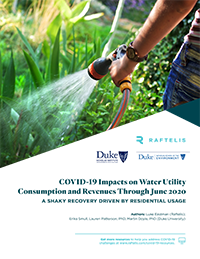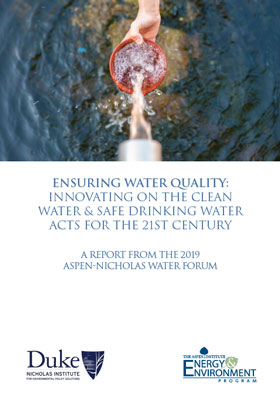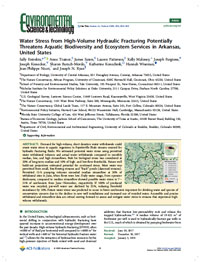Publications
COVID-19 Impacts on Water Utility Consumption and Revenues Through June 2020
May and June 2020 data for the eight water utilities in our study show diverging trends of water consumption and revenues as the COVID-19 pandemic continues, with states and local governments taking different approaches and timelines to rolling back restrictions. There are signs of recovery in water consumption and revenues for many utilities, mostly due to high residential consumption and billed revenues, not increased usage from non-residential customers.
COVID-19 Impacts on Water Utility Consumption and Revenues: Preliminary Results
Preliminary data from five water utilities of different sizes and different climates across the U.S. show variable impacts to consumption and billed revenue in response to the global pandemic. Some utilities saw a decline in primarily non-residential consumption of up to 19% and non-residential billed revenue of up to 8% in April, one full month into the pandemic, relative to April usage and revenue in the past three years. For some utilities, consumption and revenues remained similar to previous years.
Ensuring Water Quality: Innovating on the Clean Water & Safe Drinking Water Acts for the 21st Century
The 2019 Aspen-Nicholas Water Forum explored the concept of innovating the Clean Water and Safe Drinking Water Acts for the 21st Century and the ideas that undergird these two acts, their successes, shortcomings, and unintended consequences. The central question was how can innovation and regulation at local, state, and federal levels address chronic and emerging water quality challenges across the U.S.?
Federal Decentralization and Adaptive Management of Water Resources: Reservoir Reallocation by the U.S. Army Corps of Engineers
Reservoir operations must respond to changing conditions, such as climate, water demand, regulations, and sedimentation. The U.S. Army Corps of Engineers (Corps) can reallocate reservoir storage to respond to such changes. We assembled and analyzed a database of reservoir reallocations implemented and proposed by the Corps.
Managing Rivers Under Changing Environmental and Societal Boundary Conditions, Part 1: National Trends and U.S. Army Corps of Engineers Reservoirs
Most major rivers in the United States are managed by a system of reservoirs; many of which were built more than a half century ago. These reservoirs were designed based on environmental, societal, and regulatory assumptions at the time of construction. Since then, we have learned that climate is not stationary, population growth is being decoupled from energy needs and water demand, and new regulations (such as the Clean Water Act and Endangered Species Act) affect how river systems are managed.
Managing Rivers Under Changing Environmental and Societal Boundary Conditions, Part 2: Expected Compared With Experienced Conditions at U.S. Army Corps of Engineers Reservoirs
Reservoirs are critical infrastructure typically built to function as designed for 50 to 100 years. The majority of U.S. Army Corps of Engineers reservoirs are more than 50 years old. The environmental, societal, and regulatory conditions surrounding the reservoir, that is, the reservoir's expected conditions, shaped its design. Many of these expectations assumed a future similar to the past. However, recent decades have experienced warming climates, cyclical changes in precipitation, the introduction of new regulations, and populations concentrating in urban environments.
Reaching Watershed Scale Through Cooperation and Integration
"Reaching Watershed Scale Through Cooperation and Integration" summarizes the Aspen-Nicholas Water Forum discussions of May-June 2018. The forum explored how integration could address the mismatch between what has traditionally been local solutions for local water issues and emerging water challenges that impact large geographic regions, multiple sectors, and different community functions. Integration is intended to synergistically combine efforts and resources to create benefits that could not have been individually achieved. The forum explored the opportunities and challenges to integration within and between water sectors, identifying common elements for success.
A Spatially-Resolved Inventory Analysis of the Water Consumed by the Coal-to-Gas Transition of Pennsylvania
In the Journal of Cleaner Production, the Nicholas Institute for Environmental Policy Solutions Lauren Patterson and her co-authors look at changes in water consumption related to transitions from coal to natural gas in Pennsylvania from 2009 to 2012. The study provides the first comprehensive representation of changing water consumption patterns associated with the state’s coal-to-gas transition at a watershed level for both extraction of the resources to the generation of electricity with coal and natural gas.
Water Stress from High-Volume Hydraulic Fracturing Potentially Threatens Aquatic Biodiversity and Ecosystem Services in Arkansas, United States
Demand for high-volume, short duration water withdrawals could create water stress to aquatic organisms in the Fayetteville Shale streams of Arkansas sourced for hydraulic fracturing fluids this article in the journal Environmental Science and Technology suggests. Authors estimate potential water stress using permitted water withdrawal volumes and actual water withdrawals compared to monthly median, low, and high streamflows. Findings indicate that freshwater usage for hydraulic fracturing could potentially affect aquatic organisms in 7-51 percent of the catchments depending on the month. If 100 percent of wastewater was recycled, the potential impact drops. Authors suggest that improved monitoring and access to water withdrawal and streamflow data are needed to ensure protection of streams not only as sources of drinking water, but aquatic habitats.
Creating Data as a Service for U.S. Army Corps of Engineers Reservoirs
In the United States, our water data infrastructure does not allow us to consistently and quickly answer the most basic questions about our water system’s quantity, quality, and use. This report describes the challenges and opportunities of integrating U.S. Army Corps of Engineers 36 districts’ historic reservoir data and management operations. A companion tool to visualize data as well as the data files related to this report are available to view and download. Research by the authors to identify the frequency and magnitude of departures from operational targets of Army Corps-operated reservoirs is presented in the Journal of the American Water Resources Association.










